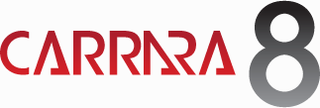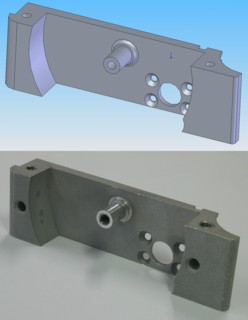
Silicon Graphics, Inc. was an American high-performance computing manufacturer, producing computer hardware and software. Founded in Mountain View, California in November 1981 by Jim Clark, its initial market was 3D graphics computer workstations, but its products, strategies and market positions developed significantly over time.

A game engine is a software-development environment designed for people to build video games. Developers use game engines to construct games for consoles, mobile devices, and personal computers. The core functionality typically provided by a game engine includes a rendering engine ("renderer") for 2D or 3D graphics, a physics engine or collision detection, sound, scripting, animation, artificial intelligence, networking, streaming, memory management, threading, localization support, scene graph, and may include video support for cinematics. Implementers often economize on the process of game development by reusing/adapting, in large part, the same game engine to produce different games
or to aid in porting games to multiple platforms.

Macromedia was an American graphics, multimedia, and web development software company (1992–2005) headquartered in San Francisco, California that produced such products as Flash and Dreamweaver. It was purchased by its rival Adobe Systems on December 3, 2005.

Open-source software (OSS) is a type of computer software in which source code is released under a license in which the copyright holder grants users the rights to study, change, and distribute the software to anyone and for any purpose. Open-source software may be developed in a collaborative public manner. Open-source software is a prominent example of open collaboration.
Free/open-source software – the source availability model used by free and open-source software (FOSS) – and closed source are two approaches to the distribution of software.

Carrara is a full-featured 3D computer graphics application featuring figure posing and editing, as well as nature modeling, in addition to traditional modeling, animation, texturing and rendering. The software is also capable of dynamic hair and fur simulations, particle effects, soft body and rigid body dynamics. Carrara is now owned and developed by DAZ 3D. Carrara is compatible with Poser and DAZ format 3D figures and props. It is further supported by a number of 3rd party plug-ins and add-ons.
The Open Design Alliance is a nonprofit organization of over 1,250 members in 50 countries which develops Teigha, a software development platform used to create engineering applications including CAD. The main idea is to make core graphics technology accessible to software developers allowing them to focus on application development.

Vero Software is a company based in Cheltenham, England, that specialises in CAD CAM.
TurboCAD is a CAD software application for 2D and 3D design and drafting which runs on Macintosh and Microsoft Windows operating systems.
Surfware, Inc. is a Camarillo, CA-based company involved in the development of CAD/CAM software.
Abandonware is a product, typically software, ignored by its owner and manufacturer, and for which no support is available. Although such software is usually still under copyright, the owner may not be tracking copyright violations.

STEP-NC is a machine tool control language that extends the ISO 10303 STEP standards with the machining model in ISO 14649, adding geometric dimension and tolerance data for inspection, and the STEP PDM model for integration into the wider enterprise. The combined result has been standardized as ISO 10303-238.
Sescoi is a developer of industrial software for computer-aided manufacturing, enterprise resource planning and extended enterprise productivity. Its WorkNC software is one of the market leaders in the CAD/CAM field and is used by more than 25% of companies in demanding countries such as Japan. Sescoi also develops WorkPLAN, a range of ERP software products for custom manufacturers and project based companies. As of 2011 Sescoi had more than 5000 customers and 11000 licenses sold worldwide. Sescoi and its products were acquired by Vero Software in January 2013.

Tata Research Development and Design Centre (TRDDC) is the first software research centre in Pune India established by
TCS in 1981.TRDDC undertakes research in Machine Learning, Software Engineering, Process Engineering and Systems Research. It is also the largest R&D facility among the network of Innovation Labs at TCS.
NX, formerly known as "UG". In 2000 Unigraphics purchased SDRC I-DEAS and began an effort to integrate aspects of both software packages into a single product which became Unigraphics NX or NX. NX is an advanced high-end CAD/CAM/CAE, which has been owned since 2007 by Siemens PLM Software.
PartXplore is a proprietary computer aided design (CAD) file viewer developed by Sescoi for reading, analyzing and sharing 3D and 2D CAD files without needing the original CAD application. It was launched in 2008 and is supported from local Vero offices. A viewer and an evaluation version are offered as freeware.
Siemens PLM Software is a computer software company specializing in 3D & 2D Product Lifecycle Management (PLM) software. The company is a business unit of Siemens, and is headquartered in Plano, Texas.

David Pearson is a British physicist and computer scientist. He has degrees in physics and theoretical physics from London University and Imperial College of Science and Technology, and in computer science from the University of Cambridge, where he did his postgraduate research in the resolution of three-dimensional matrices of second-order partial differential equation sets. Whilst still at university, he had also done early work for British Steel in the use of very high frequency oscillators in the measurement of surface roughness in a continuous strip steel rolling mill. He is an Associate of the Royal College of Science. He joined International Computers Limited in 1968 and became Head of Software Engineering, responsible for CADES, the development system for the ICL 2900 Series Operating System. In 1977 he was appointed Director of Advanced Development for Bell-Northern Research in Ottawa and Palo Alto California. In 1981 he joined the ranks of the early-80s hitech entrepreneurs and became the co-founder and President of Orcatech, one of the world's first intelligent graphics workstation companies. He went on to become the founding Chief Executive of the Strathclyde Institute in Glasgow, Scotland, Senior Director of Scottish Enterprise and Chief Executive for the economic development agency for Norfolk and Waveney. Before moving back to Canada, he spent three years as Chief Operating Officer of the Industrial Society, later to become the Work Foundation. He has Canadian and British citizenships.









